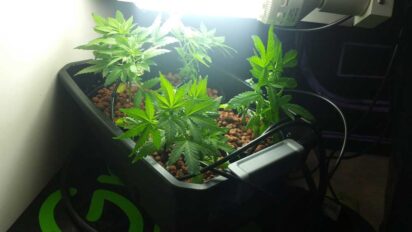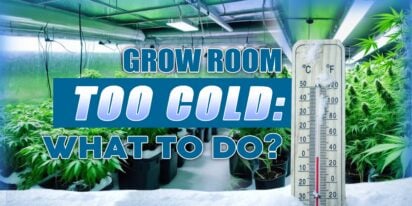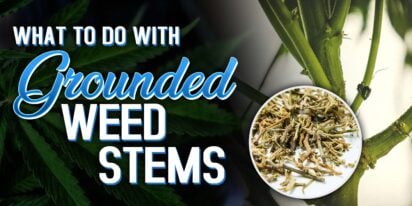
Are You 18 Or Over?
YesOr
No By clicking yes, you certify that you are over 18. By using this website, you agree to our legal disclaimer.605+ Cannabis Strains over 20 Breeders worldwide.
Table of Contents

The rise of cannabis use all over the world has led to an increase in marijuana plant cultivation among private individuals in their own homes or properties. This means that more and more people are now growing their own cannabis from seed to plant either for their own personal consumption or for the purpose of making a profit out of it.
But, because of this rise in cannabis cultivation, more players have now entered the market to compete for a share in the increasing demand for cannabis. That said, you need to be able to distinguish yourself if you want to be stand out. One of the best ways of doing so is to make sure you produce the highest quality products in the most efficient way possible.
There are plenty of ways of growing cannabis. That is one of the reasons why it is even called “weed” in the first place. Marijuana basically finds a way to grow in all sorts of environments and conditions similar to the common weed you see in your garden. And that adds to the reasons why there are several ways to cultivate these types of plants.
Among the ways you can cultivate cannabis, one of the best is using a hydroponics system.
Basically, hydroponics is the way of growing plants without the use of soil. Instead of growing them in the soil, they are placed in a mineral and nutrient-rich water solution. This makes it possible for the roots to immediately come into contact with the nutrients inside the water solution instead of having the plants use more energy to absorb the nutrients from the soil.
Growing plants in water have been in practice for quite a very long time. It can even trace its roots back in the 1600s when renowned scientist and statesman Francis Bacon wrote about it in one of his books. Then, in the late 1800s, soilless cultivation became a practice among botanists, who grew terrestrial plants in mineral-rich solutions.
In the 1920s, a researcher from the University of California Berkeley was one of the first persons to apply the modern hydroponics we use today. He was able to grow tomato vines larger than usual by using a mineral-rich water solution rather than soil. In 1937, he introduced the technique as hydroponics. The word is derived from Latin and means “water working”.
Since then, hydroponics has become a widely accepted way of growing plants. It then increased in popularity after NASA conducted extensive research on hydroponics. This method has also been used for different sorts of plants and crops. And yes, you guessed it, it is commonly used for cannabis cultivation as well.
In this type of hydroponics, the cannabis plants are grown in containers with a nutrient-rich solution. The containers can be anything such as jars or even buckets. However, not all of the roots are submerged inside the solution. Instead, some of the roots remain above so that the plant can get enough air.
The solution does not stay forever. It is usually changed depending on a fixed schedule or depending on the number of nutrients left in the solution. When the nutrients fall below the desired level, they usually add more nutrients in. In some cases, the entire solution is replaced.
Aeroponics is one of the more popular types of hydroponic growing techniques in the cannabis community. In this method, the plants are suspended and grown without the soil so that their roots are exposed to the air. They are then sprayed with a nutrient-rich mist that makes sure they get enough nutrients to grow into healthy mature cannabis plants.
The advantage of using aeroponics is that the roots are directly exposed to the nutrients by spraying the mist on them. They also get a lot of the air they need to grow properly because water can only hold in so much air. And the best part is that it prevents plants from getting waterlogged.
As the name implies, a continuous flow system constantly provides a supply of nutrient-rich water solution to the cannabis plants. This works by placing the plants in a tank or container that is continuously pumped with the solution from a reservoir. And, to make sure that the solution does not stay in the tank too long, it gets drained back into the reservoir where it will be used once again.
The continuous flow is also one of the most widely used and accepted techniques in hydroponics because it makes sure that the cannabis plants get enough water supply while preventing them from getting waterlogged. And, even though it looks like it uses a lot of water, this technique actually saves water in the long run because it consistently recycles them. That makes it ideal for anyone looking to conserve on water or for those living in places with limited access to water.
Nutrient film technique is widely used among commercial growers particularly because it makes sure that the plants get enough air and nutrients all at the same time. In this method, the cannabis plants are suspended above a tank and are placed in net pots so that they stay protected while their roots are exposed to the air. A nutrient-rich water film is then continuously pumped and drained in and out of the tank from a reservoir. What happens is that only enough of the roots are exposed to the film so that the rest of the roots’ plants will be able to collect nutrients from the air.
The reason why commercial growers mostly use this technique is that it tends to save up a lot of water while also making sure that the plant grows healthy enough to produce maximum yields. It also prevents the plants from getting burnt out from all of the feedings because it only gives the roots the necessary amount of nutrients they need to thrive well.
Now that you have an idea of what hydroponics is and what some of the more popular growing techniques are, it is now time for you to know why you should choose it as a method of growing your cannabis plants. Here are the advantages of using hydroponics:
This is the most basic reason why you should go use hydroponics. One of the advantages of doing so is that you get high-quality cannabis plants even though you do not grow them in the most ideal of conditions outdoors. Indoor growing usually results in cannabis plants that are poorer in quality. However, using hydroponics ensures that your plants can mimic the type of quality you get when you grow our cannabis in their ideal outdoor environments.
One of the advantages of using a hydroponic system in growing your cannabis plants is that you will be able to get higher yields in the long run. This is because the only limitation to the growth of your plants is light. Other than that, they will get all of the nutrients and minerals they need to grow up healthy. This means that your cannabis plants will end up growing faster to allow you to be able to harvest them more in a single year compared to if you grow them in the soil.
When you grow your cannabis in the soil, one of the things you cannot control is the amount of nutrition they receive and the time they receive it. This is because the plants’ roots themselves have to look for the nutrients in the soil. However, when using a hydroponic system, you feed the roots the nutrients instantly and a pace you can control. You also do not always leave the plants inside the substrate the entire time because the water solution continuously gets replaced on a consistent basis.
A lot of pests that adversely affect the growth of your cannabis plants live and thrive in soil. And, no matter how small these pests are, they can really do serious damage that can potentially derail your entire cannabis operation if you are not too careful. However, since you will be growing the cannabis plants without soil when using a hydroponic system, there will be no soil for the pests to live and thrive. This drastically reduces their numbers and will also lead to fewer diseases and to healthier cannabis plants.
When using soil as a substrate for your cannabis plants, you have to make sure that they get as much space as possible. The basic reason for this is that you do not want your cannabis plants to be competing for nutrients in a limited amount of soil space. But, if you use hydroponics, you do not have to worry about space. This is because you are already feeding the plants’ roots with nutrients through the nutrient-rich solution. That makes it possible for you to maximize your grow space and cultivate more plants
Now that you are aware of the advantages you get when you use hydroponics, you might already want to use your own system in your indoor cannabis operation. However, before you get started, you should also know what kind of nutrients are best used for your water solution so that you will be able to maximize the benefits of hydroponics to your cannabis plants.
Nitrogen is a vital part of what makes any kind of plant healthy. That is because they are used by the plant to produce chlorophyll and other enzymes or proteins. And, if you know your basic biology, you know that the importance of chlorophyll can never be overstated because of its vital role in photosynthesis. Nitrogen is best used in higher concentrations during the vegetative growth phase of the cannabis plants.
Potassium is important because of how it helps improve the movement of nutrients within the plant. It also improves the plants’ longevity and overall health as well. That makes it an important nutrient during the cannabis plants’ early stages of growth and during photosynthesis.
Phosphorus is what is responsible for converting solar energy into chemical energy. In simple terms, it makes it possible for the plant to use up the energy it gets from your light or heat source. That said, it is a highly important nutrient for the plant as it matures. It also improves your cannabis’ overall immunity to pests and diseases or other adverse conditions.
Most nutrient-rich solutions only contain a good amount of Nitrogen, Potassium, and Phosphorus. When you say that a solution is 20-20-20, it is made out of 20% Nitrogen, 20% Potassium, and 20% Phosphorus. The same can be said if it is 15-15-15. The rest is usually just water.
However, you can also add trace amounts of other nutrients such as calcium, sulfur, and magnesium to make your plants healthier. However, most of the time, you can already get by with a good nutrient-rich solution that has the right amount of Nitrogen, Potassium, and Phosphorus.
The first thing you need to set up is your reservoir. This is where your nutrient-rich water solution is contained and it is also where it comes from and eventually returns to. Your reservoir can be any shape or size so long as you think it is big enough to contain the necessary water needed. Also, you might want to keep a lid on it so that you will minimize water loss to evaporation as much as possible.
The reservoir will have a tube line that connects it from the air pump to the air stone, which is inside the tank. The purpose of this is to make sure your water has enough air or oxygen in it. Of course, it also has a line that connects the water pump to the grow table or tray. Lastly, there should be a drainage line that drains excess water from the tray down to the reservoir where it will be recycled.
The grow table or tray is where your plants will be held in place. It also contains and eventually drains the water that will be pumped from the reservoir to feed your cannabis plants the nutrients they need. There should also be a tube line that drains excess water down to the reservoir.
The purpose of the buckets is to hold your plants. They should have holes under them so that they will be able to drain water to the grow tray. Place the clay pellets in the bucket. The pellets will ensure that the plants stay in place. Connect the drip line from the water pump in the reservoir to the respective buckets and puncture holes that will slowly drip water into them. Introduce the plants in their own respective starter cubes and place them in the buckets.
Try running the system by filling up your reservoir with your solution and then by starting up the water pump that will pump water from the reservoir to the drip lines. Make sure that both the water pump and the air pump are always running so that there will be no standing water and that there is always air in your nutrient-rich solution. As long as your plants get enough solution, you are assured that your entire system is running well.

In recent years, the discourse surrounding secondhand marijuana smoke has gained significant attention, paralleling the legalization and increas

In the realm of cannabis culture, the practice of "wake and bake" holds a significant place, accompanied by both supporters and skeptics. As exp

Introducing the robust indica strain known as Critical Mass weed, a harmonious fusion of Afghani and Skunk #1 genetics. Delve into its essence,

Fusarium wilt cannabis represents a significant threat to cannabis cultivation, necessitating a comprehensive understanding of its intricacies.

1980s were a time of profound cultural transformation, marked by iconic fashion, music, and movies. Alongside these trends, a unique facet of '8

[ez-toc] In the deep history of cannabis cultivation, there exists a captivating and creative practice that combines the art of cultivation wit

For growers looking to get better yields and healthier cannabis plants, it's important to understand and control the cannabis soil pH levels. pH

[ez-toc] In indoor gardening, maintaining an optimal temperature within your grow tent is crucial for the health and productivity of your plant

[ez-toc] Welcome to the delightful world of cannafudge crafting, where sweetness meets sophistication, and cannabis infusion adds a unique twis

[ez-toc] You’ve finished trimming your weed, but what about those leftover stems? Don’t throw them away! These seemingly useless bits can a

Are You 18 Or Over?
YesOr
No By clicking yes, you certify that you are over 18. By using this website, you agree to our legal disclaimer.